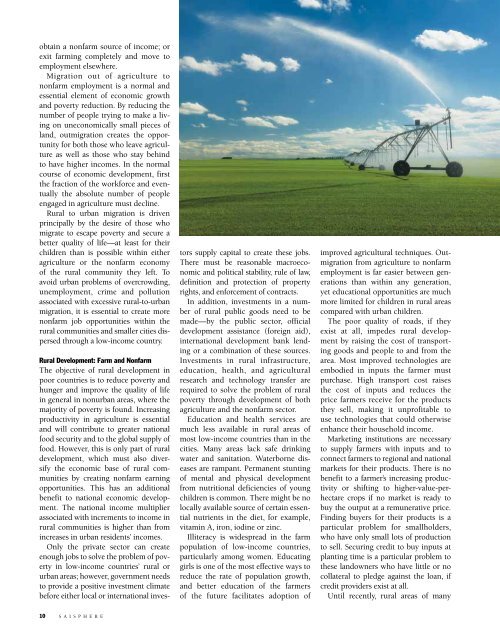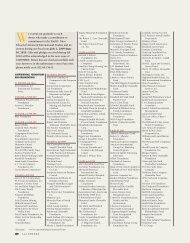Download Current Issue - SAIS
Download Current Issue - SAIS
Download Current Issue - SAIS
Create successful ePaper yourself
Turn your PDF publications into a flip-book with our unique Google optimized e-Paper software.
obtain a nonfarm source of income; or<br />
exit farming completely and move to<br />
employment elsewhere.<br />
Migration out of agriculture to<br />
nonfarm employment is a normal and<br />
essential element of economic growth<br />
and poverty reduction. By reducing the<br />
number of people trying to make a living<br />
on uneconomically small pieces of<br />
land, outmigration creates the opportunity<br />
for both those who leave agriculture<br />
as well as those who stay behind<br />
to have higher incomes. In the normal<br />
course of economic development, first<br />
the fraction of the workforce and eventually<br />
the absolute number of people<br />
engaged in agriculture must decline.<br />
Rural to urban migration is driven<br />
principally by the desire of those who<br />
migrate to escape poverty and secure a<br />
better quality of life —at least for their<br />
children than is possible within either<br />
agriculture or the nonfarm economy<br />
of the rural community they left. To<br />
avoid urban problems of overcrowding,<br />
unemployment, crime and pollution<br />
associated with excessive rural-to-urban<br />
migration, it is essential to create more<br />
nonfarm job opportunities within the<br />
rural communities and smaller cities dispersed<br />
through a low-income country.<br />
Rural Development: Farm and Nonfarm<br />
The objective of rural development in<br />
poor countries is to reduce poverty and<br />
hunger and improve the quality of life<br />
in general in nonurban areas, where the<br />
majority of poverty is found. Increasing<br />
productivity in agriculture is essential<br />
and will contribute to greater national<br />
food security and to the global supply of<br />
food. However, this is only part of rural<br />
development, which must also diversify<br />
the economic base of rural communities<br />
by creating nonfarm earning<br />
opportunities. This has an additional<br />
benefit to national economic development.<br />
The national income multiplier<br />
associated with increments to income in<br />
rural communities is higher than from<br />
increases in urban residents’ incomes.<br />
Only the private sector can create<br />
enough jobs to solve the problem of poverty<br />
in low-income countries’ rural or<br />
urban areas; however, government needs<br />
to provide a positive investment climate<br />
before either local or international inves-<br />
10 <strong>SAIS</strong>PHERE<br />
tors supply capital to create these jobs.<br />
There must be reasonable macroeconomic<br />
and political stability, rule of law,<br />
definition and protection of property<br />
rights, and enforcement of contracts.<br />
In addition, investments in a number<br />
of rural public goods need to be<br />
made—by the public sector, official<br />
development assistance (foreign aid),<br />
international development bank lending<br />
or a combination of these sources.<br />
Investments in rural infrastructure,<br />
education, health, and agricultural<br />
research and technology transfer are<br />
required to solve the problem of rural<br />
poverty through development of both<br />
agriculture and the nonfarm sector.<br />
Education and health services are<br />
much less available in rural areas of<br />
most low-income countries than in the<br />
cities. Many areas lack safe drinking<br />
water and sanitation. Waterborne diseases<br />
are rampant. Permanent stunting<br />
of mental and physical development<br />
from nutritional deficiencies of young<br />
children is common. There might be no<br />
locally available source of certain essential<br />
nutrients in the diet, for example,<br />
vitamin A, iron, iodine or zinc.<br />
Illiteracy is widespread in the farm<br />
population of low-income countries,<br />
particularly among women. Educating<br />
girls is one of the most effective ways to<br />
reduce the rate of population growth,<br />
and better education of the farmers<br />
of the future facilitates adoption of<br />
improved agricultural techniques. Outmigration<br />
from agriculture to nonfarm<br />
employment is far easier between generations<br />
than within any generation,<br />
yet educational opportunities are much<br />
more limited for children in rural areas<br />
compared with urban children.<br />
The poor quality of roads, if they<br />
exist at all, impedes rural development<br />
by raising the cost of transporting<br />
goods and people to and from the<br />
area. Most improved technologies are<br />
embodied in inputs the farmer must<br />
purchase. High transport cost raises<br />
the cost of inputs and reduces the<br />
price farmers receive for the products<br />
they sell, making it unprofitable to<br />
use technologies that could otherwise<br />
enhance their household income.<br />
Marketing institutions are necessary<br />
to supply farmers with inputs and to<br />
connect farmers to regional and national<br />
markets for their products. There is no<br />
benefit to a farmer’s increasing productivity<br />
or shifting to higher-value-perhectare<br />
crops if no market is ready to<br />
buy the output at a remunerative price.<br />
Finding buyers for their products is a<br />
particular problem for smallholders,<br />
who have only small lots of production<br />
to sell. Securing credit to buy inputs at<br />
planting time is a particular problem to<br />
these landowners who have little or no<br />
collateral to pledge against the loan, if<br />
credit providers exist at all.<br />
Until recently, rural areas of many



